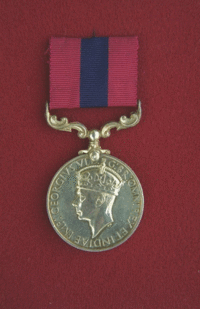Distinguished Conduct Medal
Bars
A silver, laurelled bar was awarded for a subsequent act or acts of distinguished conduct in the field.
Description
A circular, silver medal, 1.42 inches in diameter.
Obverse
King Edward VII: uncrowned, in Field Marshal's uniform, facing left, with the legend EDWARDVS VII REX IMPERATOR
King George V: uncrowned, in Field Marshal's uniform, facing left, with the legend GEORGIVS V BRITT: OMN: REX ET IND: IMP:
King George VI:
- A crowned effigy, facing left, with the legend: GEORGIVS VI D: G: BR: OMN: REX ET INDIAE IMP: (for the Second World War)
- A crowned effigy, facing left, with the legend: GEORGIVS VI DEI GRA: BRITT: OMN: REX FID: DEF: (for Korea) BIU
Medals issued to Canadians in Korea were the second type King George VI, rather than EIIR medals.
Reverse
The reverse shows FOR/DISTINGUISHED/CONDUCT/IN THE FIELD in four lines, with a horizontal line through a small oval wreath below the wording. Some Edward VII medals had the word CANADA above the inscription.
Mounting
An ornate scroll suspender is attached to the medal by a single-toe claw.
Naming
The regimental or equivalent number, rank, initials, surname and unit of the recipient are impressed in plain block capitals around the rim of the medal.
Ribbon
The crimson ribbon is 1.25 inches wide with a dark blue central stripe (0.375 inches).
Dates
The DCM was created on 04 December 1854, because of the Crimea War and was first awarded to a Canadian on 19 April 1901.
Issued
There were 2,132 awards to Canadian Army and RCAF personnel, plus 38 first bars and 1 second bar.
There have been 54 Signals recipients of the DCM and 2 Signals recipients of the first bar. Please see Distinguished Conduct Medal - Signals Recipients for a listing of the individuals.
